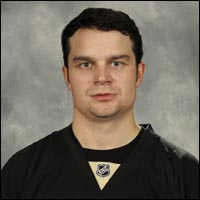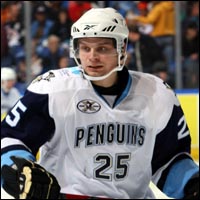by Brian Coe || AHL On The Beat Archive
 |
| Janne Pesonen has nine points and a plus-9 rating in his first seven AHL games. |
It’s rare that a professional athlete turns down a guaranteed payday in the high six figures just to compare his prowess to that of the top players in his chosen field.
But that’s exactly what Wilkes-Barre/Scranton Penguins forward Janne Pesonen has done.
A superstar in his native Finland, Pesonen led the SM-Liiga (Finland’s top league) in goals and points last season. He was named the league’s rookie of the year in 2003-04, its playoff MVP in 2007 and has played on four championship squads with Karpat in six seasons.
So it would have been easy for Pesonen to stay at home and collect a big paycheck. But the former Anaheim Ducks draftee decided to test his mettle in North America, signing a one-year deal with Pittsburgh over the summer.
“He made a decision,” said Wilkes-Barre/Scranton head coach Dan Bylsma. “He was a point getter, he was an award winner over with his team in Finland…he won championships. His attitude is ‘I want to try to play in the National Hockey League.’”
Pesonen made quite a case for a spot with Pittsburgh during his first NHL training camp, picking up three points (one goal, two assists) in four preseason games, before being assigned to Wilkes-Barre/Scranton as one of the Penguins’ final cuts.
At that point, it would have been easy for Pesonen, 26, to pack up and head overseas instead of reporting to the AHL. But the thought of trading in long bus rides for the comforts of home never crossed his mind.
“I haven’t given up hope to play in the NHL. I want to see my chances here [in Wilkes-Barre] and I want to be there [in Pittsburgh] someday,” said the 5-foot-11, 180 pound left wing. “That’s why I’m here. If I want to make money, I will go back to Europe. But not today.
“Of course it was a disappointment to be sent down. But you can’t think about it too much. You have to go out and try to get the best of you out every day, where ever you’re playing at. I’m playing here, I’m trying to improve my game here and help the team win games.”
MAKING ADJUSTMENTS
Hockey is now almost a global game. Professional leagues can be found in exotic locales such as Japan, China and Australia, as well as in the more traditional places – North America, Russia and Europe.
But there are differences in how the game is played all around the world, with one of the most obvious being rink size. While teams in North America are accustomed to an ice surface measuring roughly 200 feet long by 85 feet wide, the dimensions used in most European leagues conform to the guidelines set up by the International Ice Hockey Federation, which call for a rink width of 100 feet with a smaller neutral zone. The changes may seem like small ones to most fans, but the extra space can have big advantages.
“It’s harder to be more aggressive when you defend [on the larger surface],” said Bylsma. “You tend to stay more in the middle, protect the middle of the ice on the power play and five on five. So there’s a lot of play that happens on the outside, there’s a lot more puck possession as a result all over the ice. There’s a lot more free-flowing because there is this action on the outside.
 “So now [in the AHL] that [15] feet of ice is gone…now, if you’re standing outside, people are closing faster on you.”
“So now [in the AHL] that [15] feet of ice is gone…now, if you’re standing outside, people are closing faster on you.”
For his part, Pesonen isn’t too worried about making the adjustment from the international ice to the North American sized rink.
“I don’t think I really have problems with the small ice area. I like the smaller rink because you get more scoring chances and there’s more tempo in the game. I like that,” he said. “The style of play is a little bit different of course, because on a small rink you have to playing more simple and you can’t lose pucks.”
Bylsma isn’t too concerned either, noting that Pesonen’s work ethic and maturity are miles ahead of players who usually make the leap across the pond at a younger age.
“I don’t need to help him adjust socially or mentally. He’s doing all that himself,” said Bylsma. “It’s just a matter of him getting accustomed to his game. I’m sure he felt it was a little more scrambly here than at home, and here even than it was at Pittsburgh, being his first game in that atmosphere, the American Hockey League.
“I expect it will be periods of hockey, not games of hockey, before he adjusts to that.”
BOMBS AWAY
Military service is mandatory for all males aged 19 and older in Finland, and professional hockey players receive no exemptions.
“Everybody has to serve in the army in Finland…even the good hockey players,” joked Pesonen. “Of course we had a lot of practices and games, so we got some time off to play. But still we had to participate.”
Pesonen’s main area of expertise while serving his country was in grenades, but his hockey stick has worked more like a howitzer during his professional career. He recorded 92 goals and 216 points in 285 games with Karpat between 2001 and 2008.
But he really began to blossom during the past two seasons, combining for 133 points (56g, 77a) in just 112 games.
“I thought the past two years went great for me,” said Pesonen. “I got more ice time; I was in a big role in the team and playing with good guys. Working hard in the summer. All of those little things come together and you get confident. If you feel good on the ice, you get a big role in the team, a lot of ice time, you get a chance to play with good guys, there’s a chance to play well then.”
Even though he led the league in goal scoring last season, Pesonen isn’t averse to dishing out the puck.
“I like to make passes, and if I get scoring chances I like scoring goals,” he said. “Of course it depends on who I’m playing with. If there’s a sniper with me, I’m probably going to try to give him good passes. I like to hang around the net and sneak around, try to find lose pucks and get the rebounds.
“Whatever it takes.”
That’s just the kind of attitude that could get Pesonen his shot at the NHL.





































